by K.M. Richards
It probably seemed like a good idea at the time.
In the late 1940s, residents of Fresno and the surrounding area -- then as now, the major population center in the San Joaquin Valley region of California -- were going to great lengths to watch that new-fangled invention television via the VHF stations on the air in Los Angeles. Doing so required an expensive high-gain receiving antenna on a tall tower, aimed at Mount Wilson in the San Gabriel Mountains (about 200 miles away), coupled with a good receiver, and patience for those times when atmospheric conditions or man-made interference disrupted reception ... usually when you wanted the stations most. Still, for those with the right equipment and attitude, all four networks were available for viewing. And with the 1948 "freeze" on new television station construction, with the FCC's assurance that they were formulating a plan to bring TV to nearly every corner of America, there was great hope in Fresno that someday distant reception of the Los Angeles stations would be replaced by clear, interference-free reception of local stations providing the same network programming.
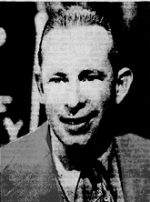
Sheldon Anderson |
Enter the Anderson family. Patriarch Herman Anderson had put KCOK/1240 in Tulare (about 45 miles to the southeast of Fresno) on the air in late 1945, followed in 1949 by the acquisition of KAFY/550 in Bakersfield, another 15 miles down U.S. Highway 99. His son Sheldon was manager of both stations ... a good choice, given his experience since 1935 at stations in Bakersfield, Redding and Fresno before tackling the initial construction of KCOK. The family watched developments in Washington DC with great interest, noting in 1951 the FCC Third Notice of Further Proposed Rulemaking's inclusion of a table of allocations which assigned channel 3 to Visalia, a mere nine miles to the northeast of Tulare. Despite Herman's passing away after a long illness on the last day of October, Sheldon filed on January 30, 1952 for that channel, no doubt hoping it would survive the final hearings and remain available for grant.
Alas, by the time the Sixth Report and Order was released the FCC had decided that a better use of a channel 3 allocation was to assign it in both Santa Barbara and Sacramento rather than Visalia, and it was replaced in the final table by UHF channels 43 and 49, but Tulare itself had gained its own assignment of channel 27 -- immediately adjacent to one of Fresno's allocations of channel 24 -- and with his original application now moot, Sheldon filed in July for it ... and quickly found himself caught between a rock and a hard place. In 1948, he had purchased a 15% interest in Fresno's KYNO/1300, but when that station's majority owners decided to file for channel 47, the overlap with the proposed channel 27 signal was impermissible. Fortunately, his father's will called for him to assume full ownership of the Tulare and Bakersfield radio stations, and when the FCC approved the transfer in March 1953 Sheldon wasted no time in divesting his stake in KYNO (which would have caused further legal difficulties as he went from 15% to 100% ownership of KCOK anyway).
That divestiture cleared the way for the FCC to grant the channel 27 application on April 2. One week later, KYNO withdrew their channel 47 application in exchange for an option to purchase 35% of the application of competitor James Edward ("J.E.") O'Neill, a local rancher and horseman of considerable local stature. Upon therefore winning the grant, O'Neill promptly named the new station after himself by choosing the call letters KJEO.
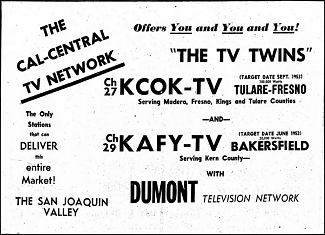 By that time, down the road in Bakersfield KAFY-TV/29 was under construction -- having been granted its CP in December 1952 -- with a target date of June 15, and the same plans were to be used to construct the KCOK-TV building midway between Tulare and Visalia. However, that proved infeasible and Sheldon instead acquired a 9500 square foot building in East Tulare that had previously housed a refrigeration company and an auto dealer, and converted it into studios with space for no fewer than six standing sets including a circular stage 19 feet in diameter with both a hydraulic lift and rotating motor. Anderson had to get a special use permit to build the channel 27 transmitter site on Eshom Point in Sequoia National Forest, more than 5,000 feet above the Valley and about 35 miles northeast of Tulare, but a 90-minute drive on winding mountain roads; in a special 22-page Tulare Advance-Register supplement the weekend before KCOK-TV began operation he said that location would allow the new station to be received as far north in the Valley as Modesto (135 miles away) and hoped that "our northern fringe [will be] actually near Stockton" (another 25 miles north, just south of Sacramento). The high elevation above the Valley floor sparked Anderson to promote KCOK-TV in early advertising as "The Mile High Station" (see below, left).
By that time, down the road in Bakersfield KAFY-TV/29 was under construction -- having been granted its CP in December 1952 -- with a target date of June 15, and the same plans were to be used to construct the KCOK-TV building midway between Tulare and Visalia. However, that proved infeasible and Sheldon instead acquired a 9500 square foot building in East Tulare that had previously housed a refrigeration company and an auto dealer, and converted it into studios with space for no fewer than six standing sets including a circular stage 19 feet in diameter with both a hydraulic lift and rotating motor. Anderson had to get a special use permit to build the channel 27 transmitter site on Eshom Point in Sequoia National Forest, more than 5,000 feet above the Valley and about 35 miles northeast of Tulare, but a 90-minute drive on winding mountain roads; in a special 22-page Tulare Advance-Register supplement the weekend before KCOK-TV began operation he said that location would allow the new station to be received as far north in the Valley as Modesto (135 miles away) and hoped that "our northern fringe [will be] actually near Stockton" (another 25 miles north, just south of Sacramento). The high elevation above the Valley floor sparked Anderson to promote KCOK-TV in early advertising as "The Mile High Station" (see below, left).
What went unmentioned -- not that the average reader would have understood anyway -- was that channel 27 would, at sign on, be one of only three UHF stations to broadcast with a directional pattern using a specially-designed General Electric antenna, the other two being KACY/14 Festus (St. Louis) MO and KTVU/36 Stockton.
KMJ-TV/24, sister station to KMJ/580 and the Fresno Bee newspaper, went on the air June 1 with a NBC network affiliation to match that of its radio partner. KAFY-TV got on the air August 10, beating by two months its VHF competitor KERO/10, and Anderson began promoting his two UHFs as the beginning of a "Cal-Central Network" -- as shown in the ad at the above left -- to provide programming of specific interest to the San Joaquin Valley. (The two stations' transmitter sites had an unobstructed microwave relay path between them, which would have allowed simulcasting programs originating at either station's studio.) That plan did not last long, though; shortly after KERO lit up he sold all but 8.3% of his interest in channel 29 to the publishers of the San Francisco Chronicle, who were already operating KRON-TV/4 in the Bay Area.
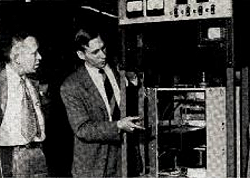
Anderson is shown the high-power Klystron tube in a
5kW UHF transmitter by DuMont engineer William H.
Sayer, Jr. It was such a tube that failed in a test
transmission the day before KCOK-TV's November
debut, delaying the inaugural broadcast. |
In the midst of all this, yet another UHF grant was made in the Valley, on August 12 for channel 53, to John Poole, who had conducted pioneering experiments in UHF television broadcasting and was about to convert his Los Angeles experimental operation into KBIC-TV/22. And some areas of the Valley were managing to receive KVEC-TV/6 from San Luis Obispo, near the California coastline, when it went on the air in May. Another competitor, for channel 34 in Merced, was applied for on May 13 and granted September 16 after New York attorney George Becker divested his minority interest of 22% of the applicant, due to his interests in five other granted CPs in Kentucky, West Virginia, Texas, Iowa and Illinois putting him over the FCC's then-limit of multiple ownership interests. After taking the call letters KMER in November, the permittee became a former permittee May 20, 1954 with the deletion of not only the Merced CP but all of the investment group's other CPs, for failure to prosecute (the FCC term for constructing station facilities after a grant).
KJEO went on the air with ABC network programming at about the same time as KERO, and -- after missing announced start dates throughout the late summer and early fall -- KCOK-TV began operation in mid-November with a reported 60-person staff and a full program schedule of ten hours on weekdays, 9½ hours on Saturdays, and 12½ hours on Sundays. On November 29, the station held an "open house" for the public before officially airing its inauguratory program featuring local civic leaders that afternoon (it had been scheduled for November 14 but one of the high-power tubes at the transmitter was found to be defective the day before, forcing a temporary test pattern to air instead for a few days using only the 100-watt exciter).
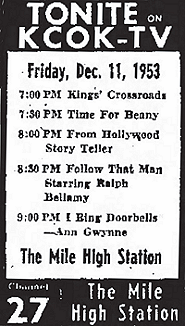 The first schedule for channel 27 was a mix of local, DuMont network, and first-run syndicated programming, including the daily 90-minute live womens' program Taylor Maid For You, named for hostess Jackie Lynn Taylor (one of the original "Little Rascals"), coming to the San Joaquin Valley after successfully establishing herself as an on-camera interviewer at KTTV/11 in Los Angeles. DuMont contributed Dollar A Second, Front Page Detective, Col. Humphrey Flack, the Hank McCune Show, The Ruggles and the by then-ubiquitous Bishop Fulton Sheen ... all on kinescope, plus Sunday's live NFL game. Syndicated programs such as Betty White's Life With Elizabeth, City Detective, Liberace, and the Paramount Network's Time For Beany filled other slots on the schedule, as well as programs with local celebrities Vern Mack (news commentary) and Jimmy Thomason (country music) plus nightly news and agricultural reports. There was also a significant amount of community-based programming, including fundraisers for the March of Dimes and the Camp Fire Girls, a weekly roundtable discussion conducted by the Tulare County Chamber of Commerce, and (in May 1954) a half-hour chat with California Governor Goodwin J. Knight, simulcast on the radio station.
The first schedule for channel 27 was a mix of local, DuMont network, and first-run syndicated programming, including the daily 90-minute live womens' program Taylor Maid For You, named for hostess Jackie Lynn Taylor (one of the original "Little Rascals"), coming to the San Joaquin Valley after successfully establishing herself as an on-camera interviewer at KTTV/11 in Los Angeles. DuMont contributed Dollar A Second, Front Page Detective, Col. Humphrey Flack, the Hank McCune Show, The Ruggles and the by then-ubiquitous Bishop Fulton Sheen ... all on kinescope, plus Sunday's live NFL game. Syndicated programs such as Betty White's Life With Elizabeth, City Detective, Liberace, and the Paramount Network's Time For Beany filled other slots on the schedule, as well as programs with local celebrities Vern Mack (news commentary) and Jimmy Thomason (country music) plus nightly news and agricultural reports. There was also a significant amount of community-based programming, including fundraisers for the March of Dimes and the Camp Fire Girls, a weekly roundtable discussion conducted by the Tulare County Chamber of Commerce, and (in May 1954) a half-hour chat with California Governor Goodwin J. Knight, simulcast on the radio station.
KCOK-TV had an advantage going in that most early UHF stations did not, and that was the fact that with the exception of the aforementioned KERO an hour away in Bakersfield, its only local competitors were also on UHF ... the lone VHF allocation, for channel 12, had just gone into comparative hearings between the owners of KFRE/940 and KARM/1430 (which was still to take an additional two years to complete -- until January 1956 -- with KFRE-TV going on the air May 10 of that year). Yet channel 27 was denied an affiliation by CBS, because KARM was their radio affiliate for the Fresno market and the network was apparently willing to wait for the coveted VHF slot, clearing some programs on KMJ-TV and KERO in the interim. (This was apparently later proved by CBS' affiliation with channel 12 even though KARM was the losing applicant; on the other hand, KFRE's channel 12 application was a sequel to one they had submitted for channel 2 in June 1944.) No explanation was ever given by the network as to why CBS programs that didn't air on channels 24 and 47 were not offered to KCOK-TV.
Poole's KBID-TV/53 came and went in the space of 153 days in 1954 (February 13 to July 15); despite transmitting from KMJ-TV's Bear Mountain tower northeast of Fresno with a decent lineup of syndicated programs such as Racket Squad, Colonel March of Scotland Yard and Rocky Jones, Space Ranger plus wrestling, roller derby, and an early evening movie each night, in suspending operations "with deep regret" Poole complained that only 50% of the market had purchased television sets and he had been unable to secure a network affiliation (in hindsight, this was likely more proof of CBS' patience in waiting for channel 12 ... like KCOK-TV, Poole's station was never offered any of the programs passed on by KMJ-TV and KJEO). Perhaps the Advance-Register had used a crystal ball when, in a brief editorial on the eve of channel 53's debut, it noted that the San Joaquin Valley would have six operating stations, "one shy of the total in the Los Angeles metropolitan area and twice as many as are in operation in San Francisco" and "we've a notion that there aren't enough advertising dollars to go around" before concluding that "something has to give." Poole held out hope that conditions would improve in the future but his construction permit instead expired on May 9, 1957 without his resuming operation.
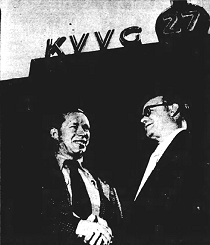
Anderson with Cordell Fray in front of the
KVVG studios, before the 1954 deal to sell
channel 27 fell through. |
Despite having relatively little competition, it quickly became apparent that Anderson had overspent in putting channel 27 on the air. After less than four months of operation, he abruptly changed the call letters to KVVG on February 1, which coincidentally matched the initials of one Vern V. Gilligan, who had recently returned to Tulare after several years of living in Hawaii and who was listed as a director of the Central California Telecasting Corporation. Anderson was conspiculously absent from the list of principals, even as he spun the call letter change as "unrelated" to "bringing in some outside interests" to the press. In any event, the following month an application was filed to transfer ownership not to Gilligan and company, but to Hollywood movie producer/director Cordell W. Fray and Los Angeles Municipal Court presiding judge Byron Walters of Los Angeles (who apparently operated the station for several months under an agreement with Anderson as Sierra Broadcasting System while the application was pending); the FCC approved the sale August 12, but the deal did not consummate. The failed sale brought to light that in addition to the $175,000 purchase price Fray and Walters were to assume $478,000 in liabilities, including $8,000 in back wages for seven employees who had filed complaints with the state labor commission ... including already-former hostess Jackie Lynn Taylor. (Four more filed not long after the sale fell through.) In announcing the collapse of the Sierra deal, Anderson told the Advance-Journal that KVVG was in discussions with "interests in northern and southern California" to form a statewide television network. It was the last time he mentioned such an effort, and in the meantime the station schedule had cutback its daily sign-on time ... first to 1:00pm in June and then to 3:00pm in August, the latter change also moving sign-off up one hour, even as programs were added from the now-defunct KBID-TV's schedule.
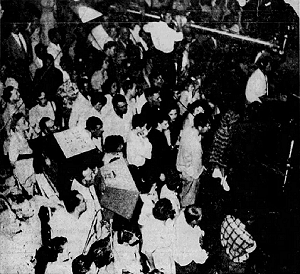
The "Save KVVG" telethon drew crowds of local residents who
watched in person at the channel 27 studios. The local Valley
newspapers gave the unusual program considerable press. |
Anderson then enlisted former station manager George C. Bowles to convene a meeting on the last day of September with his creditors -- both for channel 27 and the radio station -- to discuss options for local businessmen to take over operations in tandem with Irwin Willat,
a retired motion picture producer-director who had applied for the channel 43 allocation in Visalia. Bowles' proposal, which amounted to little more than a stock selling scheme, was rejected not only by the creditors but by station staffers. The latter had an idea of their own, however: After the owner of a store across the street offered $800 to pay the power bill, a staff meeting was held at which it was decided to hold a round-the-clock telethon appealing to viewers for financial support. And so it was that at 9:00pm on October 9 KVVG suspended all regular programming and began the unique (for its time) broadcast with an appearance by Governor Knight, who "emptied his billfold into the kitty" thus shaming his Democrat opponent in the upcoming primary into sending in a check as well. Practically every country-western performer in the area showed up for the free exposure (the Advance-Journal said they were "six deep" waiting for their turn), resulting in the arrest of one Melvin Baze, who was wanted on charges of bad check passing and was spotted in the front row of a country band during their performance by a deputy Madera County court clerk who was watching. By the time the telethon hit a record 135 hours of continuous telecasting at noon the following Friday a total of $23,335 had been pledged and $13,570 already received was being funneled into back paychecks ... a process halted after two days by the Internal Revenue Service's attaching a $8,000 tax lien to the proceeds. Unbelievably, one donation was even received from a man in faraway Montana, who was able to receive channel 27's audio carrier -- but no video -- and wanted to help. The telethon finally ended on Sunday evening the 17th and KVVG resumed its normal program schedule the next day.
But even while the station barely stayed afloat, the past due bills largely remained unpaid, and in March 1955 channel 27 was taken over by a group of creditors as the UHF Telecasting Corporation for the assumption of a remaining $350,000 in liabilities. The new primary owners of KVVG were Hollywood Motion Picture Center Studio owner Joseph Justman and Los Angeles ad agency owner M.B. Scott, who filed in June of the following year to sell their stock in the company to independent movie producer James Stacy for $10,000 plus the assumption of $300,000 in still-unpaid liabilities. (By then, Anderson had filed for bankruptcy, citing $752,985 in debts which he said were all incurred by the construction and operation of the television station.) In the midst of this latest ownership drama, KVVG went off the air for two days when the U.S. Treasury Department erroneously determined the station was delinquent in paying taxes; as it turned out, a check issued in April was never credited to their account.
The sale to Stacy was approved January 30, 1957. Channel 27 limped along for several more months before finally going dark August 6 "for 90 days due to lack of finances." (In June of that year, the rate card showed its base one-time hourly rate as being $325, compared with $550 at KMJ, $500 at KJEO and $650 at KFRE.) KVVG never returned to the air, although in 1961 Sheldon Anderson managed to get a new grant for channel 27, with the familiar KCOK-TV call letters. The FCC cancelled same during the 1965 allocation table revision, when a number of unbuilt CPs were deleted along with their assigned channels.
More of the story of Fresno and Bakersfield's stations, including how KERO and KFRE were moved from channels 10 and 12 to channels 23 and 30, is told in the article Deintermixture: When Television Almost Became All-UHF.
POSTSCRIPTS:
Sheldon Anderson sold KCOK/1240 in 1957. The purchase price included the assumption of $523,000 in liabilities. He then purchased KBMX/1470 Coalinga in 1958 before selling it one year later. As noted above, he made an abortive attempt to put channel 27 back on the air in the early 1960s. Anderson died April 3, 1973 at age 57; at the time of his death he was "broke and in failing health" according to his son Andy.
Jackie Lynn Taylor moved on to KOVR/13 Stockton-Sacramento and was named "TV Woman of the Year" by the San Francisco Chronicle in 1955 while she was working at KFSD-TV/10 San Diego as the host of the station's afternoon Pantry Playhouse movie. Three years later, NBC tried to hire her following a one-week appearance as a guest host on Today, but KFSD-TV refused to let her out of her contract and she remained there for ten years before moving up the coast to KSBW-TV/8 Salinas as an anchor and reporter, returning to Sacramento at KXTV/10 before marrying Sacramento native Jack Fries, a former CBS journalist and TV anchor-producer one year later. In the 1970s, she and her husband hosted airings of the Little Rascals shorts on XETV/6 Tijuana-San Diego before they became ministers in the nondenominational Unity Church, leading congregations in Missouri, Southern California and Nevada before retiring and returning in 1993 to Sacramento, where she and her husband ministered as chaplains in retirement communities. She passed away May 15, 2014 from Alzheimer's Disease at age 88.
Irwin Willat was awarded a grant for channel 43 in Visalia on October 6, 1954. He chose the call letters KAKI but never got on the air, finally surrendering the construction permit May 4, 1956. Norwood Patterson then applied for the channel in 1960 and operated it as KICU-TV from December 23, 1961 to October 18, 1968 (for details see the article on his father's KSAN-TV/32 San Francisco) using the former KVVG transmitter site at Eshom Point. In a quirk of history, shortly after beginning television operations Patterson also purchased KBIF/900 Fresno, from none other than channel 53's former operator John Poole. The channel 49 assignment in Visalia was never applied for, and was deleted in the 1965 allocations table revision. Channel 43 was subsequently changed to reserved non-commercial, and in 1979 was petitioned to be moved to nearby Clovis as a commercial allocation, replaced in Fresno by a restored channel 49. That petition was eventually approved and took effect June 9, 1981; three years later, the new allocation was applied for by the Catholic Diocese of Fresno and began operation as KNXT November 2, 1986. Channel 43 returned to the air as KGMC September 11, 1992 (see last postscript below).
Channel 53 returned to the air December 18, 1961 under a new license as KAIL-TV and almost immediately inaugurated a nightly two-hour block of Spanish language programming consisting of movies and local shows, also selling late evening timeslots to conservative news commentary programs such as The Manion Forum, The Dan Smoot Report and The Conservative Viewpoint. In 1964, the owners unsuccessfully attempted to swap dial positions with the reserved non-commercial educational channel 18 allocation. When that was denied, and with the schedule having been reduced to five hours per day consisting almost entirely of the free "filler" films distributed to stations by government entities and business organizations (even Smoot jumped ship, to KICU), they sold channel 53 to the owners of ethnic KTYM/1460 in the Los Angeles suburb of Inglewood for $236,500 (the sale was opposed by the Anti-Defamation League of B'nai B'rith on charges that the radio station had aired anti-Semitic remarks but was nevertheless approved just before Christmas Day 1966). KAIL went dark for a 3½ year period -- April 17, 1973 to October 7, 1976 -- to move the transmitter from a ground level location in nearby Clovis to Bald Mountain, 30 miles to the northeast, with considerably higher power. Upon resuming operation channel 53 unsuccessfully applied for over-the-air subscription television operation; it was the Fresno UPN affiliate beginning with that network's launch in 1995, then when UPN merged with The WB in 2006 to form The CW network, channel 53 affiliated with MyNetwork. In 2015, Trans-America sold KAIL to Aperio Communications, headed by Joshua Castro, Chester Smith's (founder of Modesto's KLOC-TV/19) grandson. Aperio sold the station five years later to Marion IL-based religious broadcaster Radiant Life Ministries, and at the end of September 2020 KAIL began running Christian programming from the ministry's Tri-State Christian Television satellite channel. It has identified as channel 7 (its actual broadcast channel) via PSIP and in advertising since analog television ended on June 12, 2009, but there is nothing in the records to show that the FCC ever authorized that.
Another Fresno-area UHF, KDAS/21 Hanford, went on the air February 27, 1962 but went dark on Christmas Eve 1964 (by which time they were signing on in mid-afternoon with a program schedule heavily dominated by the aforementioned free fillers and ancient Westerns and signing off just as prime time began at 8:00pm). They resumed operation with new ownership February 10, 1966 under the calls KSJV-TV, with a schedule consisting almost entirely of forgettable old movies and a daily local hour of Spanish-language programming called Festival Latino, before throwing in the towel only three months later, on May 13. (A bad omen might have been their hiring of Mel Lucas as sales manager; he was part-owner of both attempts to make channel 40 a viable concern in Sacramento in the 1950s.) The CP was deleted in December 1967 but was then reinstated four months later in order for it to be sold to Spanish International Network, which returned it to the air September 20, 1972 as KFTV, a satellite of their KMEX/34 Los Angeles.
Although as noted above the channel 27 allocation in Tulare was deleted in 1965, a new channel 26 allocation was added in August 1967 via the petition of Pappas Electronics, owner of radio stations KGEN/1370 and KGEN-FM/94.9. (In a bit of unintended amusement, the FCC order adding the allocation called it the "first local television service in the community" based on there being no operating stations with that city of license at the time.) They filed for and received a grant for the new channel and put it on the air as KMPH-TV -- the call letters stood for the Pappas brothers' first names of Mike, Pete and Harry -- on October 11, 1971. KMPH-TV operated for its first seventeen years as an independent, also carrying network programs that channels 24, 30 and 47 passed on, before becoming a Fox affiliate in 1988. The Pappas brothers filed for bankruptcy in 2008 and sold all of their television stations in October 2009.
The KVVG call letters live on in the San Joaquin Valley, thanks to LPTV entrepeneur Gary M. Cocola, who had them assigned to his channel 54 low-power station in Porterville -- about 20 miles southeast of Tulare -- in 2003. It simulcasts (along with co-owned KMSG-LD/39 Fresno, using PSIP 43.2) programming from the Spanish-language Azteca América network, which was launched in partnership with KMPH's Pappas brothers in 2000 (they also owned the network's affiliates in Los Angeles, Houston and San Francisco). The "off-channel" PSIP is possible because Cocola also owns full-power KGMC/43 in the Fresno market, which transmitted on channel 27 (where this whole saga began!) until September 1, 2020 when it traded facilties with Telemundo-owned KNSO/51 on RF 11. In a further bit of intertwining history, KMSG-LD transmits on KAFY-TV's original RF channel 29 and also leases a subchannel using what should have been KAIL's PSIP (53.1) to Joshua Castro, who retained the MyNetwork affiliation for the Fresno-Visalia market after selling channel 53.




